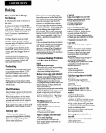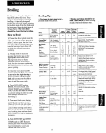
Care and Cleaning
Proper care and cleaning are
important so your range will give
you efficient and satisfactory
service. Follow these directions
carefully in caring for it to help
assure safe and proper maintenance.
Before cleaning any part of your
range (except for operating the self-
cleaning cycle),
DISCONNECT
ELECTRIC POWER TO THE
RANGE
at the fuse box or circuit
breaker panel, or pull the range
power cord plug from the electric
outlet.
Special Care of Continuous-
Cleaning Oven Interior
Your range has a Continuous-
Cleaning upper oven that cleans
itself while cooking. The inside of
the oven-top, sides, and back-
is finished with a special coating
which cannot be cleaned in the usual
manner with soap, detergents,
commercial oven cleaners, coarse
abrasive pads or coarse brushes.
Use of such cleansers and/or the
use of oven sprays will cause
permanent damage.
The special coating is a porous
ceramic material which is dark in
color and feels slightly rough to the
touch. If magnified, the surface
would appear as peaks, valleys, and
sub-surface “tunnels:’ This rough
finish tends to prevent grease
spatters from forming little beads
or droplets which run down the
side walls of a hard-surface oven
liner leaving unsightly streaks that
require hand cleaning. Instead,
when spatter hits the porous finish
it is dispersed and is partially
absorbed. This spreading action
increases the exposure of oven
soil to heated air, and makes it
somewhat less noticeable.
Soil may not disappear completely
and at some time after extended
usage, stains may appear which
cannot be removed.
The special coating works best on
small amounts of spatter,
not as
well with larger spills, especially
sugars, egg or dairy mixtures.
The special coating is not used
on oven shelves. Shelves should be
cleaned outside the oven to avoid
damage to the special coating.
To Clean the
Continuous-Cleaning Oven:
1. Let range parts cool before
handling. It is recommended that
rubber gloves be worn when
cleaning range parts manually.
2. Remove shelves and cookware.
3. Soil visibility may be reduced by
operating the oven at 450°F. Close
the door and turn OVEN TEMP
knob to 450°F. Time for at least 4
hours. Repeated cycles may be
necessary before improvement in
appearance is apparent.
REMEMBER:
DURINGTHE
OPERATION OF THE OVEN, THE
DOOR, WINDOW AND OTHER RANGE
SURFACES WILL GET HOT ENOUGH
TO CAUSE BURNS.
Do
NOT TOUCH.
4. If a spillover or heavy soiling
occurs on the porous surface, as
soon as practical after the oven has
cooled, remove as much of the soil
as possible using a small amount of
water and a stiff bristle nylon
brush. When using water, use it
sparingly and change it frequently,
keeping it as clean as possible, and
be sure to blot it up with paper
towels, cloths or sponges.
Do
not
rub or
XI-&J with paper towels,
cloths or sponges, because they
will leave unsightly lint on the
oven finish. If water leaves a white
ring on the finish as it dries, apply
water again and blot it with a clean
sponge, starting at the edge of the
ring and working toward the center.
Do not use soap, detergent,
commercial oven cleaner, silicone
oven sprays, coarse steel pads or
coarse brushes on the porous
surface.
These products will spot,
clog, and mar the porous surface
and reduce its ability to work.
Do not scrape the porous surface
with a knife or spatula-they
could
permanently damage the finish.
Outer Enamel Finish
When the range is cool, wash the
enamel finish with mild soap and
water or a mild abrasive cleanser
applied with a damp cloth. Rinse
the surface with clean water and
dry with a soft cloth. If you wish,
occasionally apply a thin coat of
mild cleaning wax to help protect
the finish.
There are a number of precautions
you can take to avoid marring the
surface of the range and to prevent
it from becoming dull. Don’t slide
heavy
pans across it. If you spill
foods with a lot of acid (tomatoes,
sauerkraut, fruit juices, etc.) or
foods with high sugar content,
clean them up as soon as possible.
If allowed to remain, these foods
could cause a dull spot. Also, no
matter how stubborn the food stain,
never use
harsh abrasive cleansers.
They
could permanently damage
the enamel surface.
Control Panels
It’s a good idea to wipe the control
panels clean after each use of the
oven. For a more thorough
cleaning, the control knobs can be
removed by pulling them off the
knob stems. Clean with mild soap
and water; rinse with clean water;
and polish dry with a soft cloth.
Don’t mix up OVEN TEMP knobs.
The one with BROIL printed on it
belongs in the lower position.
Do not use abrasive cleansers,
strong liquid cleaners or oven
cleaners on the control panel as
they will damage the finish.
14


















